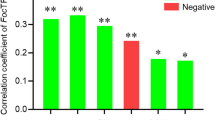Abstract
Trichoderma hamatum, T. harzianum andT. koningii were isolated from wheat and rye-grass roots from a field in Western Australia. Frequency of occurrence ofTrichoderma spp. was higher on roots subjected to washing only, for both wheat and rye-grass than the roots which were surface-sterilized with 0.6% or 1.25% NaOCl.Trichoderma spp. were recovered at a higher frequency on PDA amended with lactic acid (pH 4.5) than on PDA alone (pH 5.6) or PDA with streptomycin. In general,Trichoderma spp. were isolated at a higher frequency from roots of wheat than that of rye-grass.T. hamatum occurred at a higher frequency in rye-grass roots than in wheat, whereasT. harzianum was more common in roots of wheat than in rye-grass, especially in seedling and milky ripe stages.T. koningii was recovered at a higher frequency from roots at seedling stage of rye-grass than wheat, the reverse being true at tillering stage.T. koningii was not recovered from roots of either host in any sampling when they were surface sterilized with 1.25% NaOCl.
The take-all fungus was isolated from wheat and rye-grass roots more frequently at tillering and stem extension stages than others. It was severely pathogenic to both hosts in sterilized and non-sterilized soil.
Addition of lactic acid, HCl or streptomycin to PDA did not affect the growth of theTrichoderma spp. tested, but the growth was slower on Martin's medium than on other media. In generalT. harzianum andT. koningii grow faster thanT. hamatum. The growth of the three species were not different at 20 and 25°C, but at 15°c growing of all species was significantly reduced.
Incorporation of lactic acid into PDA prevented the bacterial growth in all treatments. Streptomycin too reduced but to a lesser degree than lactic acid. Surface sterilization with NaOCl decreased the recovery of both bacteria and fungi.
T. hamatum andT. koningii reduced the mortality of wheat and rye-grass plants inoculated with the take-all fungus in sterilized and non-sterilized soil, whereT. harzianum did not protect wheat or rye-grass from infection by the take-all fungus.
Similar content being viewed by others
References
Ahmad J S and Baker R 1987 Rhizosphere competence ofTrichoderma harzianum. Phytopathology 77, 182–189.
Brennan R F, Gartrell J W and Robson A D 1980 Reaction of copper with soil affecting its availability to plants. I. Effect of soil type and time. Aust. J. Soil Res., 18, 447–459.
Chang Y-C, Baker R, Kleifeld O and Chet I 1986 Increased growth of plants in the presence of the biological control agentTrichoderma harzianum. Plant Dis. 70, 145–148.
Cook R J and Baker K F 1983 The Nature and Practice of Biological Control of Plant Pathogens. The American Phytopathological Society. St Paul Minn.
Cotterill P J and Sivasithamparam K 1987 Take-all inoculum: Its occurrence and distribution within a wheat crop and fallow. Soil Biol. Biochem. 19, 221–222.
Falloon R E 1985 Fungi pathogenic to rye-grass seedlings. Plant and Soil 86, 79–86.
Harley J L and Waid J S 1955 A method of studying active mycelia on living roots and other surfaces in the soil. Trans. Br. mycol. Soc. 38, 104–118.
Large E C 1954 Growth stages in cereals, Illustrations of the Feeke's sccale. Pl. Pathol. 3, 128–129.
Liu S D and Baker R 1980 Mechanism of biological control in soil suppressive toRhizoctonia solani. Phytopathology 70, 404–412.
Martin J P 1950 Use of acid, rose bengal and streptomycin in the plate method for estimating soil fungi. Soil Sci. 69, 215–232.
Papavizas G C 1985 Trichoderma and Gliocladium: Biology, ecology and potential for biocontrol. Ann. Rev. Phytopathol. 23, 23–54.
Widden P and Abitbol J J 1980 Seasonality ofTrichoderma species in a spruce-forest soil. Mycologia 72, 775–784.
Widden P 1984 The effect of temperature on competition for spruce needles among sympatric species of Trichoderma. Mycologia 76, 873–883.
Widden P 1986 Seasonality of forest soil micro-fungi in southern Quebec. Can. J. Bot. 64, 1413–1423.
Widden P 1987 Fungal communities in soils along an elevation gradient in northern England. Mycologia 79, 298–309.
Author information
Authors and Affiliations
Rights and permissions
About this article
Cite this article
Dewan, M.M., Sivasithamparam, K. Identity and frequency of occurrence ofTrichoderma spp. in roots of wheat and rye-grass in Western Australia and their effect on root rot caused byGaeumannomyces graminis var.tritici . Plant Soil 109, 93–101 (1988). https://doi.org/10.1007/BF02197585
Received:
Revised:
Issue Date:
DOI: https://doi.org/10.1007/BF02197585




